Instruction
5 ways senior golfers can improve consistency

One of the most difficult issues that golfers over 50 struggle with more than younger golfers is golf consistency. In this article we will tackle the top five issues golfers can address today to achieve tour-like precision and consistency.
Incidentally, regularly striking the sweet spot is one of the top issues affecting power and distance.
Consistent ball contact is really about executing the correct mechanics. As we have discovered, mechanics are much more difficult to execute when the body is limited by age-related factors. Many golfers struggle with this. Golfers enjoy hitting the ball beautifully one day, and spend the next frustrated wondering where their swing went.
It seems that this is one of the primary reasons golfers fail to drill down and work on mechanics. Because, every now and again, it all comes together and they hit the ball great. They tend to believe they just need to keep practicing instead of exploring the root cause of the swing problem and changing the swing.
Remember that every so often the stars will align and golfers can play a fantastic round of golf with bad mechanics. But there exists little margin for mistakes — all the components must be working perfectly. This is the reason why most golfers have difficulty playing consistently good golf.
In contrast, a golfer with a sound golf swing can even strike the golf ball “well” on an off day when the stars do not align. With good mechanics, they have a greater margin for error.
In summary, if golfers take the time to correct their mechanics, the odds are in their favor and they can still play well, even if they are having a “bad” day. However, the player who does not master the following mechanics will tend to only play well when all their idiosyncrasies are working in perfect timing. The result: no consistency.
1. Let Us Begin With the Quick Tips
The following tips are easy and simple to incorporate.
Quiet the Legs: Regardless of how sound your golf mechanics are, having over-active legs will ruin your golf consistency. Over-active legs are hard to control and very difficult to be consistent with.
Focusing on quiet legs is also one of our top tips to salvage a bad round of golf. Give it a try the next time you are having a difficult time with golf consistency.
The second quick tip is to relax your hands, wrists, and elbows. Again, a flawless golf swing is no match for stiffness in these key joints that control your release into the golf ball.
2. Head and Spine Movement is Much More Difficult to Control in the Senior Golfer
Loss of flexibility is a big issue with senior golfers because in order to maintain their range of motion, they have to stretch. Some do and some don’t. Basically, you want your body to be in a consistent position while you swing the club: You want pure rotation and minimal side-to-side movement and up-and-down movement with your body.
Golfers over 50 struggle with this more due to bad posture. If golfers are unable to keep their mid-back flat in the golf swing, the spine will not be able to rotate very much. When this occurs, most golfers over 50 have to stand up in their backswing and then flex down again in their downswing. PGA pros do this on purpose in the golf swing to add power, but it is very difficult to be consistent with for the average every day golfer.
In addition, golfers over 50 tend to lack enough neck rotation to keep the head still in the backswing. As a result the head rotates and pops up. As far as I am aware, nobody on the planet purposely moves their head very much during the back swing, because it makes consistency extremely difficult.
3. Right Foot Position at the Top of the Backswing
Again, one of the keys to golf consistency is to eliminate excessive and unnecessary moving parts. A key component of this is to prevent backwards swaying in the backswing. Many times swaying is caused by limited right, or trail, leg hip flexibility. Either way, a simple method to control lateral sway is to make sure you feel your body’s weight stay on the inside of your trail foot at the top of the backswing.
If you feel your weight travel to the outside of the foot, then you are likely sacrificing consistency. The age old drill that you can use on the range, is to have a golf ball under the outside of your back foot while you swing and hit balls. Just remember to allow your back foot to come off of the ball as you transition to impact and follow through.

Place golf ball under outside of back foot. Take some practice swings and hit balls. Remember to allow your foot to come off the ball naturally in your follow through.
4. Wrist Position at the Point of Impact
At the position of impact, the lead wrist needs to be flat and the trail wrist needs to be “cupped,” or bent. If the lead wrist hinges, also known as “flipping” because the club moves in front of the hands, the club head will bottom out, or reach its lowest point behind the ball instead of in front of the ball as desired. This increases the odds that the golfer hits the ground and takes a divot before hitting the golf ball.
The golfer is also more likely to hit the ball thin because if the the club head reaches its lowest point behind the ball, it may only ascend to the golf ball. As a result, the ball will typically be hit low on the club face missing the sweet spot, or worse, hitting the leading edge of the golf club. When the leading edge hits the ball, it will roll on the ground (topping the ball) or result in low screamers that fly past the target. Either way, it is nearly impossible to be consistent unless your wrists are in the right spot.
5. Weight Distribution from Impact to Follow Through
One characteristic that all great iron players and swing methodologies have in common is that their weight is centered or forward of center at impact and in the follow through.
The reason why your weight should be positioned more forward at impact is the same reason given for wrist positions: to allow the golf club to bottom out after you hit the ball. If you hang back on your back foot, the club head will bottom out before the ball.
This is true with the exception of the driver and some tee shots. With the driver, you want to hit the ball on an ascending path. But you can get away with this with consistency, because the ball is on a tee instead of being on the ground.
Finally, even with the driver, your weight should naturally finish on your lead foot with only the toes of the trail foot touching the ground.
Check these keys for tour-like precision and reliable results!
- LIKE118
- LEGIT9
- WOW7
- LOL5
- IDHT5
- FLOP8
- OB1
- SHANK22
Instruction
The Wedge Guy: The easiest-to-learn golf basic

My golf learning began with this simple fact – if you don’t have a fundamentally sound hold on the golf club, it is practically impossible for your body to execute a fundamentally sound golf swing. I’m still a big believer that the golf swing is much easier to execute if you begin with the proper hold on the club.
As you might imagine, I come into contact with hundreds of golfers of all skill levels. And it is very rare to see a good player with a bad hold on the golf club. There are some exceptions, for sure, but they are very few and very far between, and they typically have beat so many balls with their poor grip that they’ve found a way to work around it.
The reality of biophysics is that the body moves only in certain ways – and the particulars of the way you hold the golf club can totally prevent a sound swing motion that allows the club to release properly through the impact zone. The wonderful thing is that anyone can learn how to put a fundamentally sound hold on the golf club, and you can practice it anywhere your hands are not otherwise engaged, like watching TV or just sitting and relaxing.
Whether you prefer an overlap, interlock or full-finger (not baseball!) grip on the club, the same fundamentals apply. Here are the major grip faults I see most often, in the order of the frequency:
Mis-aligned hands
By this I mean that the palms of the two hands are not parallel to each other. Too many golfers have a weak left hand and strong right, or vice versa. The easiest way to learn how to hold the club with your palms aligned properly is to grip a plain wooden ruler or yardstick. It forces the hands to align properly and shows you how that feels. If you grip and re-grip a yardstick several times, then grip a club, you’ll see that the learning curve is almost immediate.
The position of the grip in the upper/left hand
I also observe many golfers who have the butt of the grip too far into the heel pad of the upper hand (the left hand for right-handed players). It’s amazing how much easier it is to release the club through the ball if even 1/4-1/2″ of the butt is beyond the left heel pad. Try this yourself to see what I mean. Swing the club freely with just your left hand and notice the difference in its release from when you hold it at the end of the grip, versus gripping down even a half inch.
To help you really understand how this works, go to the range and hit shots with your five-iron gripped down a full inch to make the club the same length as your seven-iron. You will probably see an amazing shot shape difference, and likely not see as much distance loss as you would expect.
Too much lower (right) hand on the club
It seems like almost all golfers of 8-10 handicap or higher have the club too far into the palm of the lower hand, because that feels “good” if you are trying to control the path of the clubhead to the ball. But the golf swing is not an effort to hit at the ball – it is a swing of the club. The proper hold on the club has the grip underneath the pad at the base of the fingers. This will likely feel “weak” to you — like you cannot control the club like that. EXACTLY. You should not be trying to control the club with your lower/master hand.
Gripping too tightly
Nearly all golfers hold the club too tightly, which tenses up the forearms and prevents a proper release of the club through impact. In order for the club to move back and through properly, you must feel that the club is controlled by the last three fingers of the upper hand, and the middle two fingers of the lower hand. If you engage your thumbs and forefingers in “holding” the club, the result will almost always be a grip that is too tight. Try this for yourself. Hold the club in your upper hand only, and squeeze firmly with just the last three fingers, with the forefinger and thumb off the club entirely. You have good control, but your forearms are not tense. Then begin to squeeze down with your thumb and forefinger and observe the tensing of the entire forearm. This is the way we are made, so the key to preventing tenseness in the arms is to hold the club very lightly with the “pinchers” — the thumbs and forefingers.
So, those are what I believe are the four fundamentals of a good grip. Anyone can learn them in their home or office very quickly. There is no easier way to improve your ball striking consistency and add distance than giving more attention to the way you hold the golf club.
More from the Wedge Guy
- The Wedge Guy: Golf mastery begins with your wedge game
- The Wedge Guy: Why golf is 20 times harder than brain surgery
- The Wedge Guy: Musings on the golf ball rollback
- LIKE84
- LEGIT13
- WOW5
- LOL1
- IDHT0
- FLOP4
- OB1
- SHANK8
Instruction
Clement: Stop ripping off your swing with this drill!

Not the dreaded headcover under the armpit drill! As if your body is defective and can’t function by itself! Have you seen how incredible the human machine is with all the incredible feats of agility all kinds of athletes are accomplishing? You think your body is so defective (the good Lord is laughing his head off at you) that it needs a headcover tucked under the armpit so you can swing like T-Rex?
- LIKE0
- LEGIT2
- WOW2
- LOL0
- IDHT0
- FLOP0
- OB0
- SHANK2
Instruction
How a towel can fix your golf swing
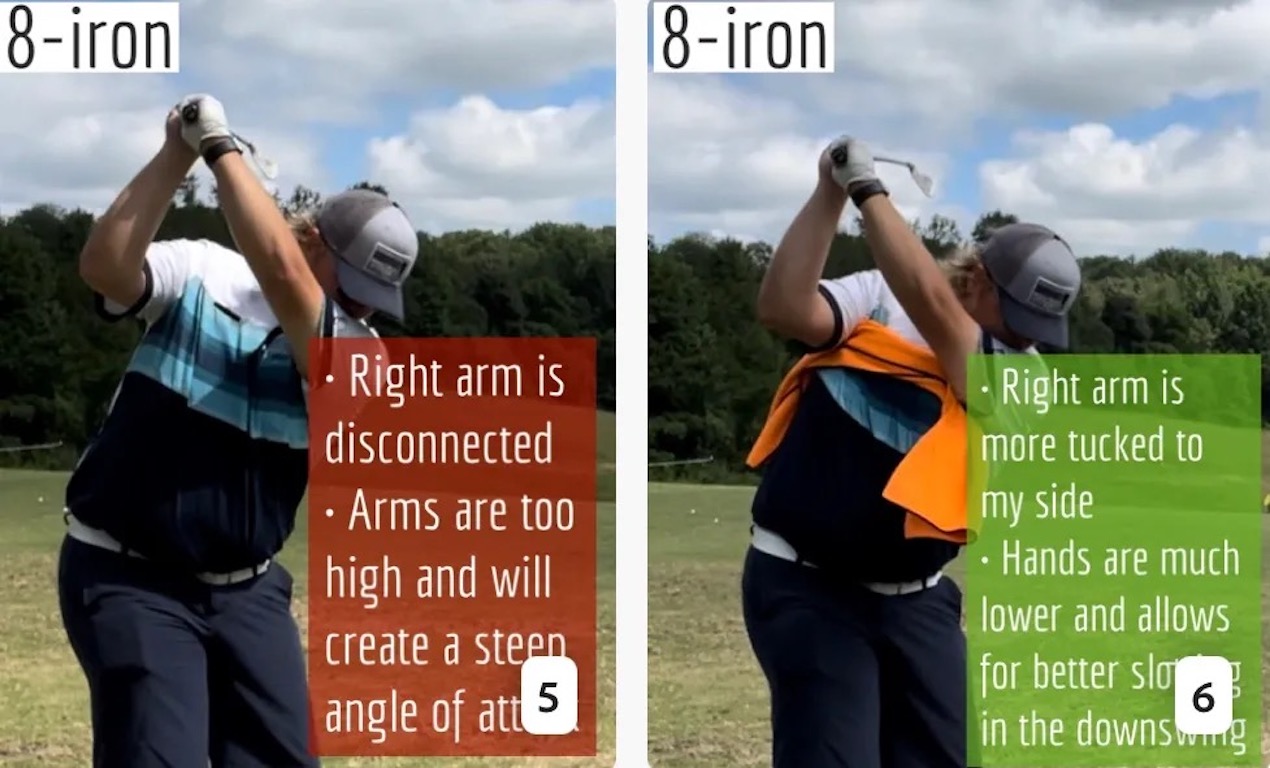
This is a classic drill that has been used for decades. However, the world of marketed training aids has grown so much during that time that this simple practice has been virtually forgotten. Because why teach people how to play golf using everyday items when you can create and sell a product that reinforces the same thing? Nevertheless, I am here to give you helpful advice without running to the nearest Edwin Watts or adding something to your Amazon cart.
For the “scoring clubs,” having a solid connection between the arms and body during the swing, especially through impact, is paramount to creating long-lasting consistency. And keeping that connection throughout the swing helps rotate the shoulders more to generate more power to help you hit it farther. So, how does this drill work, and what will your game benefit from it? Well, let’s get into it.
Setup
You can use this for basic chip shots up to complete swings. I use this with every club in my bag, up to a 9 or 8-iron. It’s natural to create incrementally more separation between the arms and body as you progress up the set. So doing this with a high iron or a wood is not recommended.
While you set up to hit a ball, simply tuck the towel underneath both armpits. The length of the towel will determine how tight it will be across your chest but don’t make it so loose that it gets in the way of your vision. After both sides are tucked, make some focused swings, keeping both arms firmly connected to the body during the backswing and follow through. (Note: It’s normal to lose connection on your lead arm during your finishing pose.) When you’re ready, put a ball in the way of those swings and get to work.
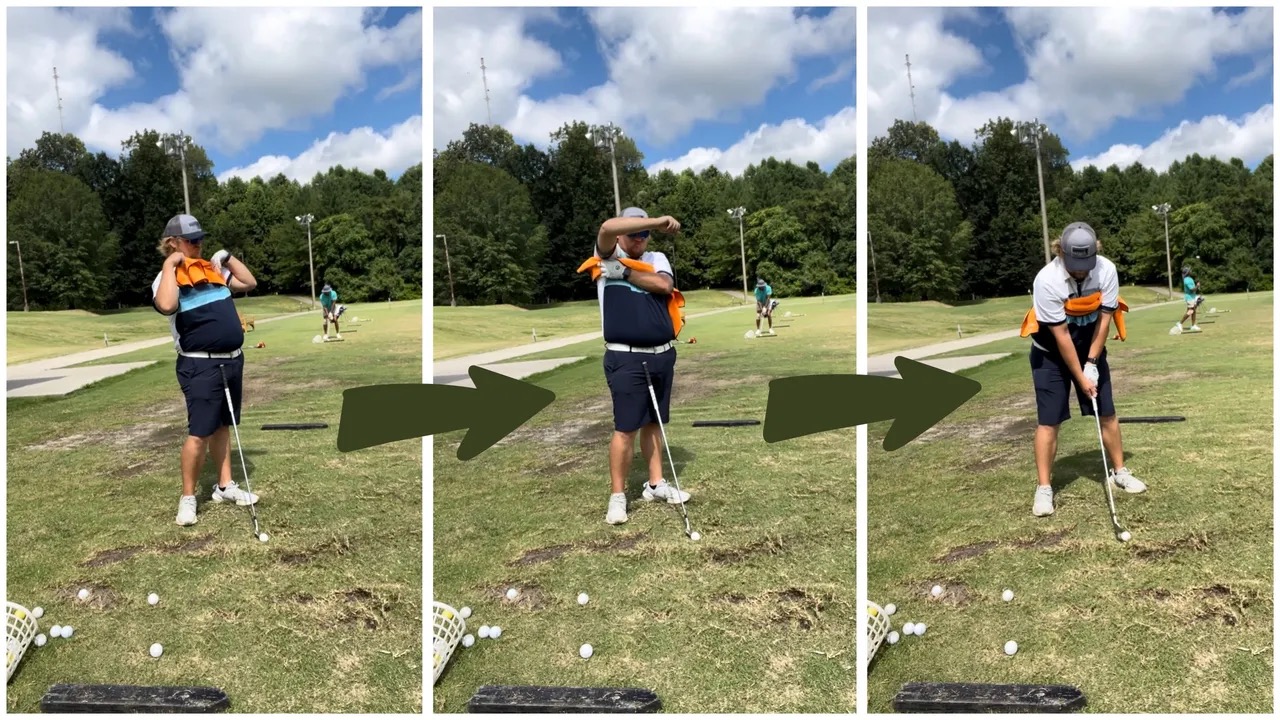
Get a Better Shoulder Turn
Many of us struggle to have proper shoulder rotation in our golf swing, especially during long layoffs. Making a swing that is all arms and no shoulders is a surefire way to have less control with wedges and less distance with full swings. Notice how I can get in a similar-looking position in both 60° wedge photos. However, one is weak and uncontrollable, while the other is strong and connected. One allows me to use my larger muscles to create my swing, and one doesn’t. The follow-through is another critical point where having a good connection, as well as solid shoulder rotation, is a must. This drill is great for those who tend to have a “chicken wing” form in their lead arm, which happens when it becomes separated from the body through impact.
In full swings, getting your shoulders to rotate in your golf swing is a great way to reinforce proper weight distribution. If your swing is all arms, it’s much harder to get your weight to naturally shift to the inside part of your trail foot in the backswing. Sure, you could make the mistake of “sliding” to get weight on your back foot, but that doesn’t fix the issue. You must turn into your trial leg to generate power. Additionally, look at the difference in separation between my hands and my head in the 8-iron examples. The green picture has more separation and has my hands lower. This will help me lessen my angle of attack and make it easier to hit the inside part of the golf ball, rather than the over-the-top move that the other picture produces.
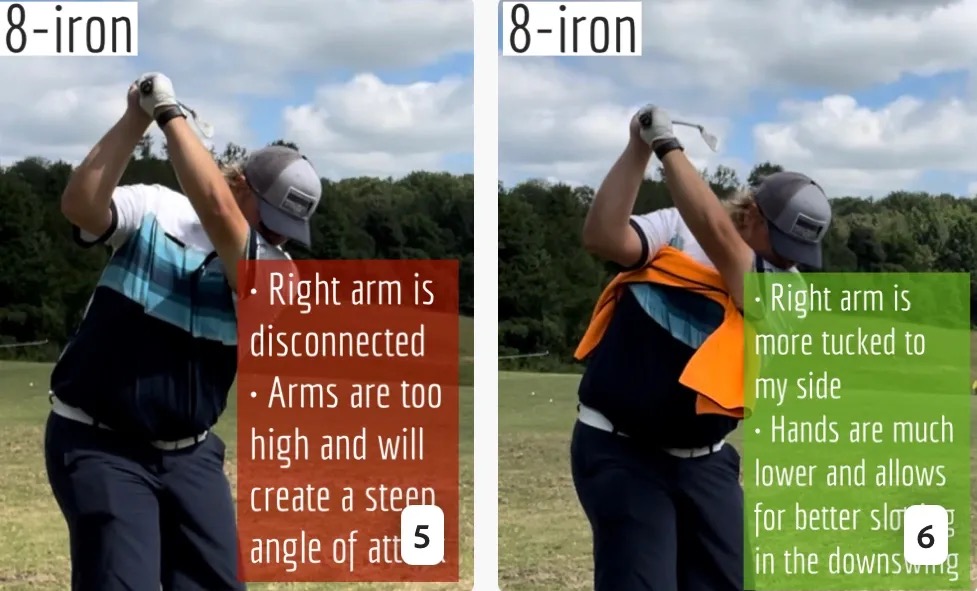
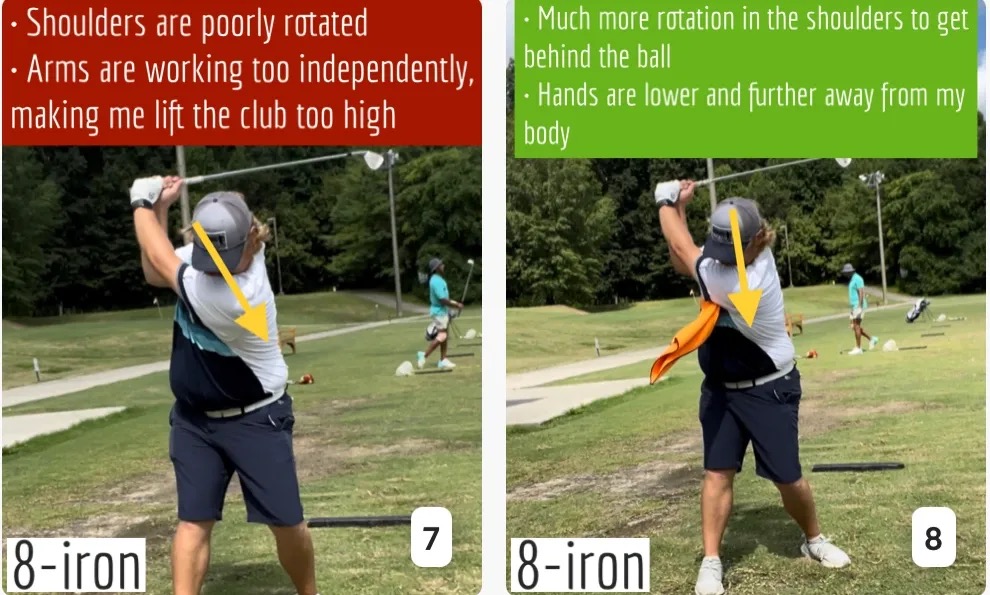
Stay Better Connected in the Backswing
When you don’t keep everything in your upper body working as one, getting to a good spot at the top of your swing is very hard to do. It would take impeccable timing along with great hand-eye coordination to hit quality shots with any sort of regularity if the arms are working separately from the body.
Notice in the red pictures of both my 60-degree wedge and 8-iron how high my hands are and the fact you can clearly see my shoulder through the gap in my arms. That has happened because the right arm, just above my elbow, has become totally disconnected from my body. That separation causes me to lift my hands as well as lose some of the extension in my left arm. This has been corrected in the green pictures by using this drill to reinforce that connection. It will also make you focus on keeping the lead arm close to your body as well. Because the moment either one loses that relationship, the towel falls.
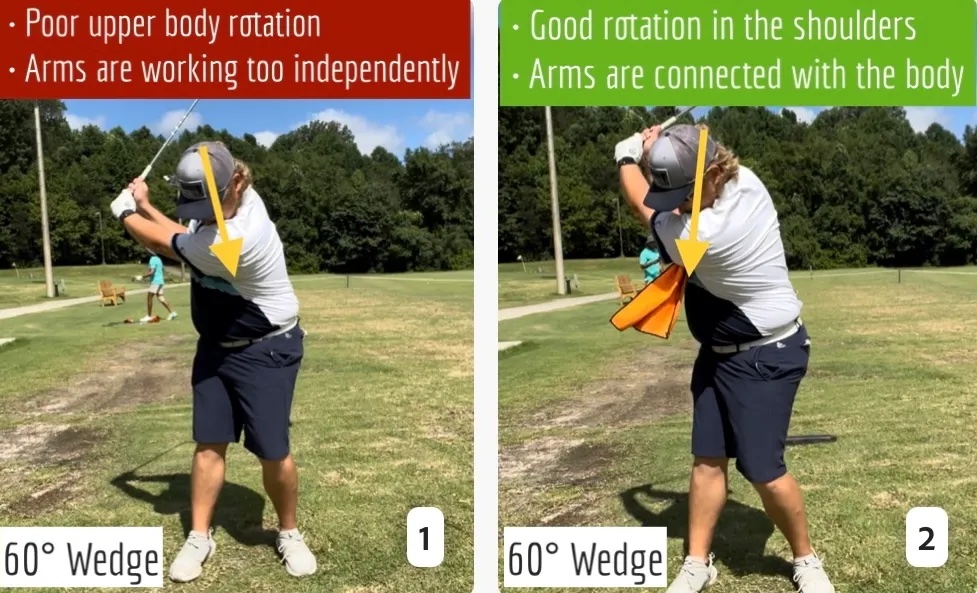
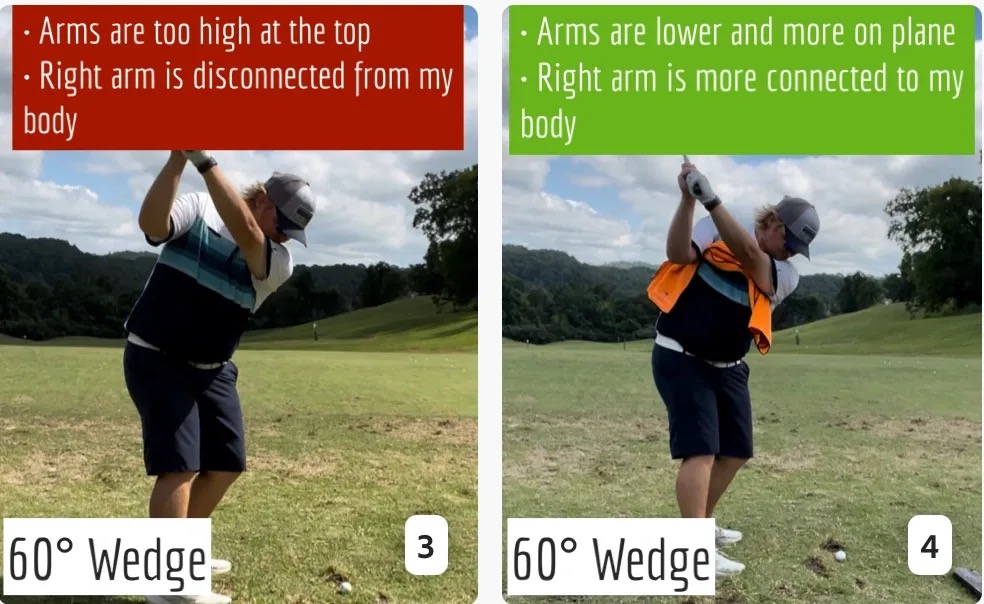
Conclusion
I have been diligent this year in finding a few drills that target some of the issues that plague my golf game; either by simply forgetting fundamental things or by coming to terms with the faults that have bitten me my whole career. I have found that having a few drills to fall back on to reinforce certain feelings helps me find my game a little easier, and the “towel drill” is most definitely one of them.
- LIKE12
- LEGIT2
- WOW2
- LOL0
- IDHT0
- FLOP2
- OB0
- SHANK8
-

 19th Hole5 days ago
19th Hole5 days agoDave Portnoy places monstrous outright bet for the 2024 Masters
-
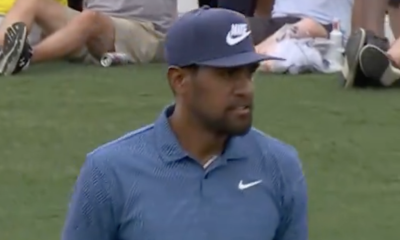
 19th Hole2 weeks ago
19th Hole2 weeks agoThings got heated at the Houston Open between Tony Finau and Alejandro Tosti. Here’s why
-

 19th Hole6 days ago
19th Hole6 days agoTiger Woods arrives at 2024 Masters equipped with a putter that may surprise you
-

 19th Hole2 weeks ago
19th Hole2 weeks agoReport: Tiger Woods has ‘eliminated sex’ in preparation for the 2024 Masters
-

 19th Hole1 day ago
19th Hole1 day agoTwo star names reportedly blanked Jon Rahm all week at the Masters
-

 19th Hole2 weeks ago
19th Hole2 weeks agoAddiction, spinal fusion, and scam artists – Everything Anthony Kim revealed in candid interview with David Feherty
-

 19th Hole1 week ago
19th Hole1 week agoAnthony Kim says doctors told him that he ‘may not have much time left’ ahead of LIV return
-
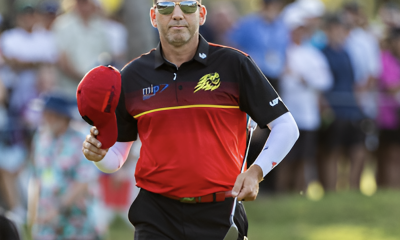
 19th Hole1 week ago
19th Hole1 week agoBrooks Koepka and Sergio Garcia make significant equipment changes as 2024 Masters looms














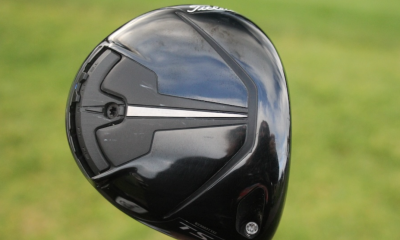







Terry
Jan 6, 2019 at 6:42 pm
Seldom will any golfer find a level lie between tee to green. Thus, balance (and being able to maintain “dynamic” balance throughout the swing) is the true challenge for golfers, especially, senior players like, myself.
Although, I’m only able to play one or two rounds per month, I’m still in love with the game and always searching for ways to improve. My tip is eat as healthy as you possibly can, get plenty of rest, stretch your body for at least 10-15 minutes, everyday, and walk with hand weights for at least 45 minutes/daily.
You need core strength and flexibility in order to maintain stable posture and balance during a swing, otherwise, you can’t control the low point of the passing clubhead at impact. If you are out of shape and lack flexibility, it’s a hit or miss proposition, really…
I marvel, at times, just how difficult it is to play this game with any consistency now that I’m in my 60’s. Are bodies are constantly changing so adjustments have to be made if you want to play this game, well, for the rest of your life. Please, keep this in mind when you go out, next week, and play a round. Golf is a very challenging sport and it can never be “mastered”. The Tom Watson and Bernhard Langer’s of the world are, literally, one in a “billion”.
Pingback: Let’s Talk Golf! - Trillium Woods Independent Senior Living
Michael Baker
Apr 7, 2016 at 11:45 am
Hi There, great website for the senior golfer. Keep up the good work.
Regards,
Michael
http://www.bogeystobirdies.co.uk
Tom Donnelly
Jul 10, 2013 at 1:28 pm
Since I only started swinging a golf club 3 years ago at age 55, it’s interesting to look at the “over 50” advice and try to apply it to my situation. Since I never played as a limber young man, I did not experience losing any of the speed or flexibility upon turning 50. I don’t have any idea what it feels like to swing a golf club as a kid. Since I’ve only played for 3 years, I tend to attribute my “swing flaws” to inexperience rather than advancing age. There’s probably an element of both, so articles like this are very helpful.
Susan Forbes
Jul 10, 2013 at 9:34 am
Thanks for this timely article. I’ve been struggling with this issue all season and am happy to find some useful information. Much appreciated.